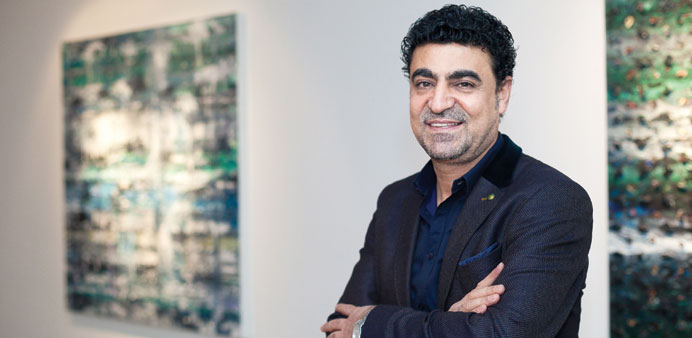By Denise Marray/Gulf Times London Correspondent
Heartscapes”, “sadscapes”, “hopescapes” – certainly much more than landscapes. When looking at the latest work by Syrian artist Thaier Helal, you can sense in the intricate layers of paint, textures and colours a myriad of experiences and emotions that speak about the country.
“For me, it’s not just landscapes - it is something behind; I’m talking about the lives of the people there through a mix of abstract and contemporary art. It’s not just images – it is a complicated mix of things,” said Helal.
He explained that his work is a reflection on his homeland and the tragedy that is being experienced in Syria at this time.
Just one story he related gives an impression of the kind of personal memories that are moulded into his art. He described his meetings with a remarkable Jesuit priest, Father Paolo Dall’Oglio. The Rev Paolo Dall’Oglio lived in Syria for 30 years, helping to restore Deir Mar Musa, a 6th-century monastery 80 kilometres north of Damascus, and forming a religious community dedicated to Christian-Muslim dialogue and harmony.
“The people who live there are Muslims, but they gave him their support to build the monastery, and he became like one of the family. He knew everyone and everyone knew him and liked him,” recalled Helal.
Dall’Oglio criticised Bashar al-Assad for his ruthless crackdown on those who opposed his rule, and as a consequence, in 2012, he was ordered to leave Syria. He did so, but fatally he returned the following year to al-Raqqah to try and negotiate the release of some hostages. He was kidnapped and is believed to have been killed by IS terrorists.
“He has just disappeared,” said Helal.
It’s just one tragedy among thousands upon thousands of individual stories of suffering and loss caused by hatred and intolerance.
“Remember how we lived there together without problems? I cannot believe what is happening now in my country when just a few years ago there wasn’t a problem and nobody cared whether a person was Shia, Sunni, Alawite or Christian,” he commented.
One of the landmarks that inspires his work is the Asi-Orontes - the only river in the region flowing in a northerly direction, draining from western Asia to the Levant coastline of the Mediterranean Sea. The river rises in the mountains of Lebanon continuing into the Syrian Arab Republic for about 325 km, before arriving in Turkey for its last reach of 88km to the Mediterranean Sea.
“This river has meaning for me and is inspirational to me; the fact that it moves in a different direction to the other rivers – just like the Syrian people who are following their own course because they need to change something,” said Helal.
Inspiration is also taken from the mountains. Many of Helal’s Mountain series paintings are rendered from memory, particularly compositions depicting the imposing rock formations near the historic town of Maaloula in central Syria, a few kilometres from his birthplace. Numerous Syrian artists have painted the town since the modern period, especially the tiered homes that are built into its mountainside, yet few have captured its significance as a place of cultural pluralism given the survival of Western Aramaic among its residents, who belong to various sects.
In Helal’s recent works, the mountainous region symbolises Syria’s rich history, above all the survival of its culture through the many civilizations that have flourished across its diverse landscapes.
Born in Syria in 1967, Helal graduated from the Faculty of Fine Arts, Damascus, before relocating to Sharjah in the 1990s, where he currently lives and works. He is the recipient of numerous awards, including the Grand Gold Award at the Contemporary Painting Biennial, Tehran (2005); and the Award for Painting at the Sharjah International Biennial (1997). Helal has also contributed to the development of regional art as a long time faculty member of the University of Sharjah, Fine Arts College.
“The UAE is a good place for me – I can travel easily from Dubai to symposiums and exhibitions in any country and I have the chance to meet many artists based in the UAE, as well as those who come to Dubai for exhibit their work,” he said.
He has worked closely with Ayyam Gallery founders for the past seven years.
Asked about his opinion of the young artists now trying to make their way in Syria, he said: “They are very, very creative; the new generation are very open- minded and talented. They have different ideas to express themselves, particularly as they have access to the internet and social and new media.
“I also learn from my students in Sharjah. They learn so quickly, and when I see the results of their work I often get a big surprise – they are doing amazing things.”
Asked about what he feels at launches when he is in a room full of people, many strangers, who are reacting to his work, he said: “It’s like a new language – suddenly you find someone who understands you and they get your message. Painting is my language, and when I feel that someone can ‘read’ it and understand it that is the essence of the relationship between me and a person in the gallery. Some people love it and some don’t like it or ‘get it’ but they say they can appreciate it.”

Syrian artist Thaier Helal: u201cI cannot believe what is happening now in my country when just a few years ago there wasn’t a problem and nobody cared wh
